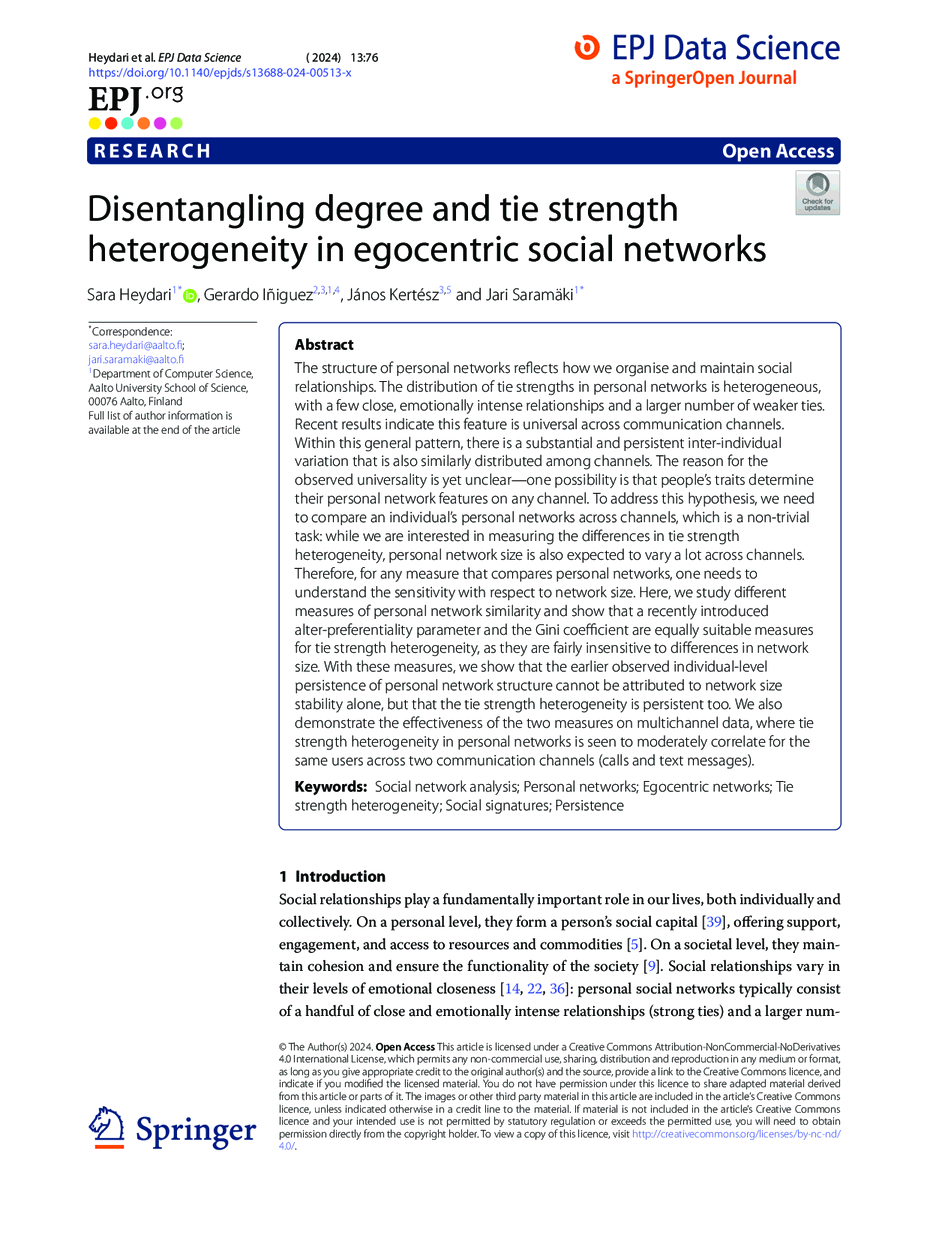https://doi.org/10.1140/epjds/s13688-024-00513-x
Research
Disentangling degree and tie strength heterogeneity in egocentric social networks
1
Department of Computer Science, Aalto University School of Science, 00076, Aalto, Finland
2
Faculty of Information Technology and Communication Sciences, Tampere University, 33720, Tampere, Finland
3
Department of Network and Data Science, Central European University, 1100, Vienna, Austria
4
Centro de Ciencias de la Complejidad, Universidad Nacional Autonóma de México, 04510, Ciudad de México, Mexico
5
Complexity Science Hub, 1080, Vienna, Austria
a
sara.heydari@aalto.fi
b
jari.saramaki@aalto.fi
Received:
29
March
2024
Accepted:
22
November
2024
Published online:
18
December
2024
The structure of personal networks reflects how we organise and maintain social relationships. The distribution of tie strengths in personal networks is heterogeneous, with a few close, emotionally intense relationships and a larger number of weaker ties. Recent results indicate this feature is universal across communication channels. Within this general pattern, there is a substantial and persistent inter-individual variation that is also similarly distributed among channels. The reason for the observed universality is yet unclear—one possibility is that people’s traits determine their personal network features on any channel. To address this hypothesis, we need to compare an individual’s personal networks across channels, which is a non-trivial task: while we are interested in measuring the differences in tie strength heterogeneity, personal network size is also expected to vary a lot across channels. Therefore, for any measure that compares personal networks, one needs to understand the sensitivity with respect to network size. Here, we study different measures of personal network similarity and show that a recently introduced alter-preferentiality parameter and the Gini coefficient are equally suitable measures for tie strength heterogeneity, as they are fairly insensitive to differences in network size. With these measures, we show that the earlier observed individual-level persistence of personal network structure cannot be attributed to network size stability alone, but that the tie strength heterogeneity is persistent too. We also demonstrate the effectiveness of the two measures on multichannel data, where tie strength heterogeneity in personal networks is seen to moderately correlate for the same users across two communication channels (calls and text messages).
Key words: Social network analysis / Personal networks / Egocentric networks / Tie strength heterogeneity / Social signatures / Persistence
Supplementary Information The online version contains supplementary material available at https://doi.org/10.1140/epjds/s13688-024-00513-x.
© The Author(s) 2024
 Open Access This article is licensed under a Creative Commons Attribution-NonCommercial-NoDerivatives 4.0 International License, which permits any non-commercial use, sharing, distribution and reproduction in any medium or format, as long as you give appropriate credit to the original author(s) and the source, provide a link to the Creative Commons licence, and indicate if you modified the licensed material. You do not have permission under this licence to share adapted material derived from this article or parts of it. The images or other third party material in this article are included in the article’s Creative Commons licence, unless indicated otherwise in a credit line to the material. If material is not included in the article’s Creative Commons licence and your intended use is not permitted by statutory regulation or exceeds the permitted use, you will need to obtain permission directly from the copyright holder. To view a copy of this licence, visit http://creativecommons.org/licenses/by-nc-nd/4.0/.
Open Access This article is licensed under a Creative Commons Attribution-NonCommercial-NoDerivatives 4.0 International License, which permits any non-commercial use, sharing, distribution and reproduction in any medium or format, as long as you give appropriate credit to the original author(s) and the source, provide a link to the Creative Commons licence, and indicate if you modified the licensed material. You do not have permission under this licence to share adapted material derived from this article or parts of it. The images or other third party material in this article are included in the article’s Creative Commons licence, unless indicated otherwise in a credit line to the material. If material is not included in the article’s Creative Commons licence and your intended use is not permitted by statutory regulation or exceeds the permitted use, you will need to obtain permission directly from the copyright holder. To view a copy of this licence, visit http://creativecommons.org/licenses/by-nc-nd/4.0/.





